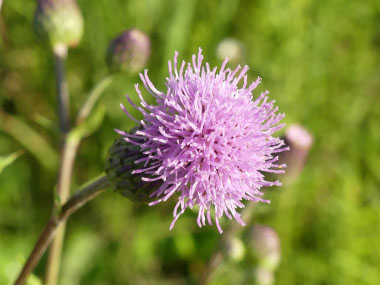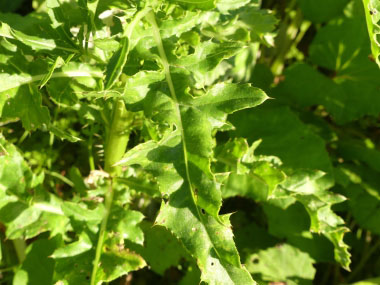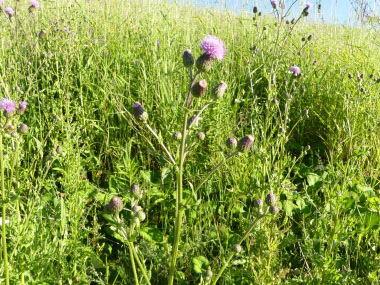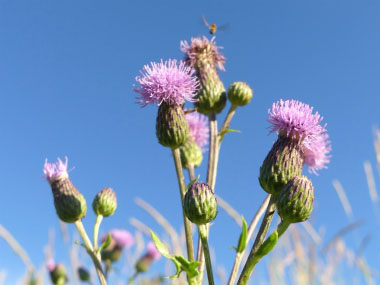








To support our efforts please browse our store (books with health benefits, etc.).
The Canada thistle is a perennial species of flowering plant in the Asteraceae family. It is native throughout Europe and northern Asia, and widely introduced elsewhere. This thistle is also commonly known as the creeping thistle and field thistle. Canada thistle develops seed sparingly and may produce 1,000 to 1,500 seeds per flowering shoot. Seeds are viable in the soil for up to 20 years. Unlike other thistles, the Canada thistle has a deep and wide-spreading root system. Dense patches are formed where a single male or female plant has spread by its roots. Individual roots only live for about two years. Small fragments of the roots can sprout new thistle plants.
Distinguishing Features
Canada thistle is generally not seen until its small purple flower heads (which are found in clusters) are in bloom. The bracts beneath the flower heads do not have spines. Once in bloom it is easily identified as a thistle. The barbed leaves and tall stem are also distinguishing features of this plant.
Flowers
Flower heads are comparatively small, 5 to 15 mm (1/5 to 3/5") wide and about twice as long. They are lilac to purple (rarely white) and occur in clusters at branch tips. The petals are ray florets and they have a sweet vanilla scent. Flower bracts are spineless. Typically the flowers are pinkish to lilac, but some flowers can be almost white. The Canada thistle flowers June to late September in the northern hemisphere.
 Fields
of Nutrition has medicinal benefits and vitamin/mineral content of Canada Thistle.
Fields
of Nutrition has medicinal benefits and vitamin/mineral content of Canada Thistle.
Leaves
Canada thistle leaves measure 5 to 17 cm (2 to 8”) long, are narrow, with crinkled, deeply lobed, and spiny edges. Base leaves are stalkless and clasping, or extended down the stem. They occur alternate on the stem.
Height
This plant can grow anywhere up to 1.5 metres (4') tall. Stems are slender, green, and freely branched.
Habitat
It is commonly found on roadsides, cultivated fields and pastures, logged forests, and other disturbed areas. It prefers sunny locations and sdoes not do well in shady areas. Canada thistle grows on every continent with the exception of Antarctica.
Edible Parts
Although leaves, stems and flowers are edible needless to say you must wear protective gloves and clothing when harvesting. The barbs must be removed from the leaves and the stems are to be shaved with a knife. This plant has a nice flavour. The stems can be prepared as crudites, added to vegetable dishes or roasted.
Other Name
Creeping Thistle.
Similar Plants
Wavyleaf Thistle.
Winter Survival Food Handbook

PDF Plant Magazines
Types of Wild Food
Geographic Zones Seasons
Disclaimer
EdibleWildFood.com is informational in nature. While we strive to be 100% accurate, it is solely up to the reader to ensure proper plant identification. Some wild plants are poisonous or can have serious adverse health effects.
We are not health professionals, medical doctors, nor are we nutritionists. It is up to the reader to verify nutritional information and health benefits with qualified professionals for all edible plants listed in this web site. Please click here for more information.
Why Edible Wild Food?
- Food costs are rising
- Free, wild food is readily abundant
- Wild food adds nutrition to your diet
- Wild food can help treat various medical conditions





